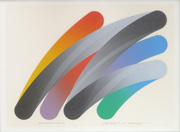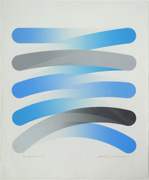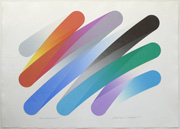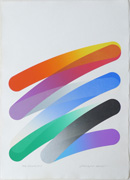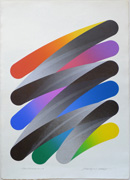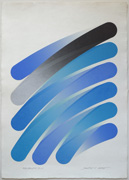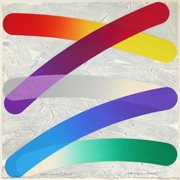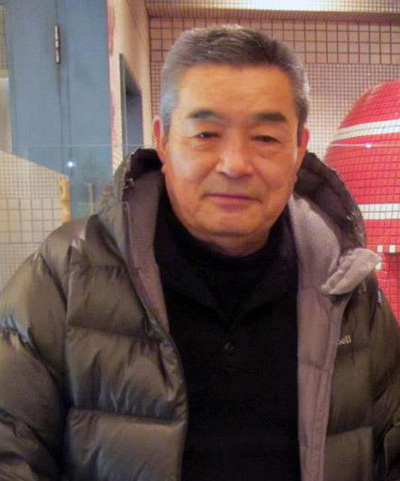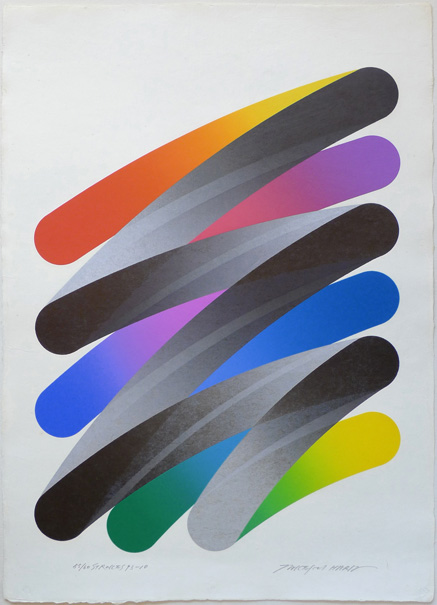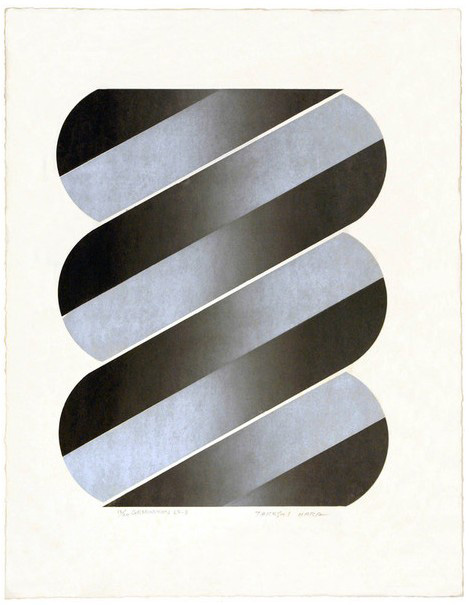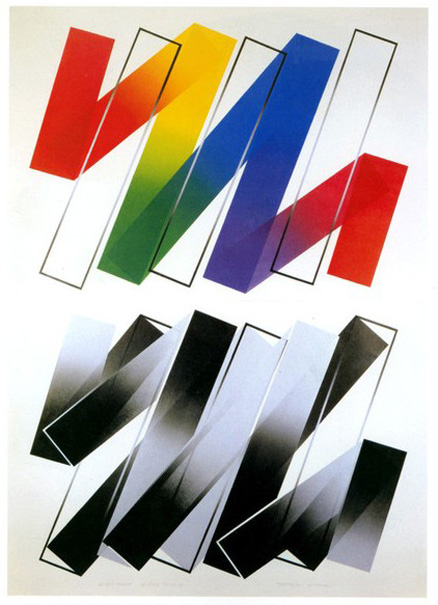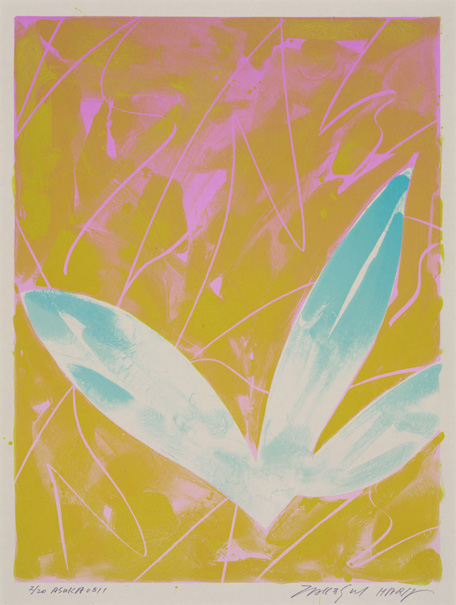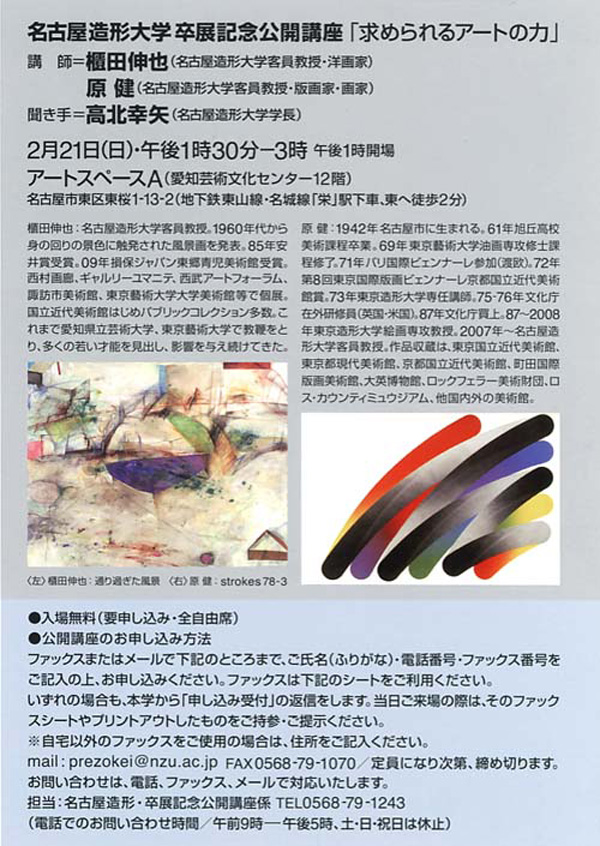Prints in Collection
Strokes 81-21, 1981 IHL Cat. #166 | Strokes 81-40s, 1981 IHL Cat. #167 |
| Strokes 93-7, 1993 IHL Cat. #693 | Strokes 93-9, 1993 IHL Cat. #694 | Strokes 93-10, 1993 IHL Cat. #695 |
| Strokes 93-11, 1993 IHL Cat. #696 | Strokes 93-13, 1993 IHL Cat. #697 |
Biographical Data
Sources: 44 Modern Japanese Print Artists, Gaston Petit, Kodansha International Ltd., 1973, p. 121-122; Collecting Modern Japanese Prints, Then and Now, Mary and Norman Tolman, Charles E. Tuttle Company, 1994, p. 126; Contemporary Japanese Prints: Symbols of a Society in Transition, Lawrence Smith, Harper & Row Publishers, 1985, p. 28-29; the artist’s website http://www.takeshihara.com/
Artistic Career
In 1967 Hara took the artist name (gō) Ken Hara and had his first solo show. While initially exhibiting large irregular-shaped canvases, hand painted with lacquer, Hara moved on to applying paint “with a spray gun so as to achieve a perfect evenness unattainable by hand”1 and then almost exclusively to print making. Petit states that Hara turned to prints to achieve “artistic objectivity” in which the artistic work is severed from its creator, “a state perfectly attainable in printmaking where even the worked plate exists independently of the artist. Hara feels that this distance creates objectivity, whereas in oil painting there always remains a personal relationship, an interposing hand, a sensibility which is never dispassionate.”2
According to Petit, Hara chose lithography for its “smooth quality of the finish” that “evokes a sensuous coolness…” Tolman adds that “The particular effects that he realized in his lithographs are more apt to be found in silkscreens. The delicate shadings, subtle blending of colors and luminosity are difficult to achieve, but Hara has developed a special technique with a method of applying the ink with huge rollers to give his work an element of unbelievable smoothness, lushness, and control.”
Hara’s work is often described, using Minimalist language, as “pristine, dispassionate and self-contained” and “with no personal involvement.” However, as Petit points out, “because of the difficulty of controlling his magnificent technique of color gradation, Hara must do this work himself; hence a certain personal involvement is an indispensable part of the fabric… “
While his work may appear to be only about “color or form”, his “subject matter is, in fact, deeply rooted in his own culture”3 and “deeply inspired by old Japanese motifs.”4
Hara’s print work is distinguished by his in depth exploration of single motifs, the most prominent of which is his long running series of prints titled Strokes, created between 1973 and the mid-1990s. Other print series exploring single motifs are titled Gradation (1969 to 1973), No Focus (1970-1972) and more recently Asuka.
In his series Strokes, represented in this collection by eight works, Hara has employed “an extraordinary range of subtle colors” in creating curved and straight oblong strokes to achieve a traditional, but most modern, form of Japanese calligraphy. As Smith states “the gradations of the strokes and the finesse of their changes of direction directly recall the movements of brush and ink” in traditional Japanese calligraphy.
Teaching
“Japan’s leading teacher of the lithographic technique,”6 started his long teaching career in 1973 as a lecturer in the Department of Painting, Tokyo Zokei University where he was to gain a full professorship and retire from in 2008 as Professor Emeritus. Hara also lectured at the Tokyo National University of Fine Arts from 1983 to 1987. As a teacher he has guided many artists, "including Wako Shuji (b. 1953), whose own work reflects his mentor’s fastidious attention to color and flawless technique."7 In 2008, Hara was honored with an exhibition titled "Harvest –Works of Takeshi HARA and 161 artists", Towa Gallery, Tokyo, commemorating his lifetime of teaching and work. Currently, Hara is a Visiting Scholar at Nagoya Zokei University of Art and Design.
Exhibitions and Shows
Collections (partial list)
National Museum of Modern Art, Tokyo; National Museum of Modern Art, Kyoto; Tokyo Metropolitan Museum of Contemporary Art; Cincinnati Art Museum; British Museum, London; The Japan Foundation, Tokyo; The Machida International Print Museum of Art; Rockefeller Foundation of Art; Art Gallery of New South Wales; National Gallery of Australia; University of Alberta Art Collection; The Art Gallery of University of Maryland; Harvard Art Museums/Fogg Museum
2 Ibid.
3 Collecting Modern Japanese Prints, Then and Now, Mary and Norman Tolman, Charles E. Tuttle Company, 1994, p. 126.
4 op. cit., Petit
5 Contemporary Japanese Prints: Symbols of a Society in Transition, Lawrence Smith, Harper & Row Publishers, 1985, p. 28.
6 op. cit., Tolman
7 Ibid.
Biography
Takeshi Hara 原健 (b. 1942)Sources: 44 Modern Japanese Print Artists, Gaston Petit, Kodansha International Ltd., 1973, p. 121-122; Collecting Modern Japanese Prints, Then and Now, Mary and Norman Tolman, Charles E. Tuttle Company, 1994, p. 126; Contemporary Japanese Prints: Symbols of a Society in Transition, Lawrence Smith, Harper & Row Publishers, 1985, p. 28-29; the artist’s website http://www.takeshihara.com/
borrowed from the artist's Facebook page https://www.facebook.com/takeshiharaken | Takeshi (Ken) Hara was born in Nagoya-shi, Aichi in 1942 and now lives in Tokyo. He was trained at the Tokyo University of Fine Arts and Music receiving a B.A. in painting in 1967 and an M.A. in painting in 1969. According to Petit, “The artist’s reaction to his university years was one of pronounced resistance. As time went on, he developed a certain allergy to things Western: the plaster models to be copied, the books to be studied, the materials and techniques used, all flowed from Western academies, and students were imbued with Western ideals. He gravitated toward the print course, where no regulated beauty was dictated and where aesthetic views emerged in a freer atmosphere.” Starting with his participation in the 1971 Paris Biennale, Hara began his international travels, first through Europe, then in 1975 to Egypt and Morocco and, under the auspices of the Japanese Agency for Cultural Affairs’ Overseas Study Program for Artists, to the UK and the United States and various Central American countries. |
Artistic Career
In 1967 Hara took the artist name (gō) Ken Hara and had his first solo show. While initially exhibiting large irregular-shaped canvases, hand painted with lacquer, Hara moved on to applying paint “with a spray gun so as to achieve a perfect evenness unattainable by hand”1 and then almost exclusively to print making. Petit states that Hara turned to prints to achieve “artistic objectivity” in which the artistic work is severed from its creator, “a state perfectly attainable in printmaking where even the worked plate exists independently of the artist. Hara feels that this distance creates objectivity, whereas in oil painting there always remains a personal relationship, an interposing hand, a sensibility which is never dispassionate.”2
According to Petit, Hara chose lithography for its “smooth quality of the finish” that “evokes a sensuous coolness…” Tolman adds that “The particular effects that he realized in his lithographs are more apt to be found in silkscreens. The delicate shadings, subtle blending of colors and luminosity are difficult to achieve, but Hara has developed a special technique with a method of applying the ink with huge rollers to give his work an element of unbelievable smoothness, lushness, and control.”
Hara’s work is often described, using Minimalist language, as “pristine, dispassionate and self-contained” and “with no personal involvement.” However, as Petit points out, “because of the difficulty of controlling his magnificent technique of color gradation, Hara must do this work himself; hence a certain personal involvement is an indispensable part of the fabric… “
While his work may appear to be only about “color or form”, his “subject matter is, in fact, deeply rooted in his own culture”3 and “deeply inspired by old Japanese motifs.”4
Hara’s print work is distinguished by his in depth exploration of single motifs, the most prominent of which is his long running series of prints titled Strokes, created between 1973 and the mid-1990s. Other print series exploring single motifs are titled Gradation (1969 to 1973), No Focus (1970-1972) and more recently Asuka.
| Strokes, 93-10, 1993 (IHL Cat. #694) | No Focus 72-25,26, 1972 (from the artist's website) | Asuka 0511, 2005 (Library of Congress) |
In his series Strokes, represented in this collection by eight works, Hara has employed “an extraordinary range of subtle colors” in creating curved and straight oblong strokes to achieve a traditional, but most modern, form of Japanese calligraphy. As Smith states “the gradations of the strokes and the finesse of their changes of direction directly recall the movements of brush and ink” in traditional Japanese calligraphy.
Teaching
“Japan’s leading teacher of the lithographic technique,”6 started his long teaching career in 1973 as a lecturer in the Department of Painting, Tokyo Zokei University where he was to gain a full professorship and retire from in 2008 as Professor Emeritus. Hara also lectured at the Tokyo National University of Fine Arts from 1983 to 1987. As a teacher he has guided many artists, "including Wako Shuji (b. 1953), whose own work reflects his mentor’s fastidious attention to color and flawless technique."7 In 2008, Hara was honored with an exhibition titled "Harvest –Works of Takeshi HARA and 161 artists", Towa Gallery, Tokyo, commemorating his lifetime of teaching and work. Currently, Hara is a Visiting Scholar at Nagoya Zokei University of Art and Design.
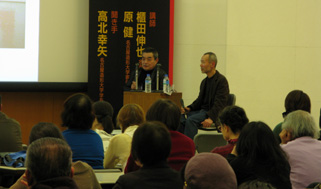 | 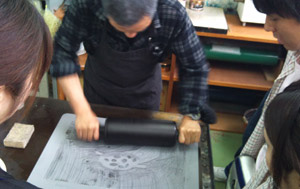 |
Artist lecturing at Nagoya Zokei University of Art and Design and teaching lithography to 3rd year students
Exhibitions and Shows
| 1969 Shell Art Exhibition, prize; 1972, 7th Japan Art Festival, Tokyo and Mexico; 1976; 12th Florence International Print Biennial; 1976, grant from the Cultural Affairs Agency for one year of study and travel abroad; 1982 Deibu Print Competition, Tokyo, first grand prize; 1985, Contemporary Japanese Print, Tokyo Metropolitan Art Museum; 1990, Group show, Retretti Art Cenre, Finland; 1991, 5th Taiwan International Print Biennial; 1992, NICAF, Yokohama; 1997 prints of the 20th century (Tokushima Prefectural Museum of Art); 1999 6th Exposicion Litografia Argentina Contemporáneo, Buenos Aires; 2000 Japanese Art Exhibition of the 20th Century Museum of Contemporary Art Tokyo Art forefront with 25 artists (Ikeda Museum of 20th Century Art); 2001 Art Kite Museum Opening, Germany; 2004 "HANGA - East/West Exchanges waves" exhibition (Tokyo National University of Fine Arts Museum; 2007 Awagami printmaking exhibition "Printmakings in 6 artists"; 2007-2008 The 40th Anniversary of the Japanese Government Overseas; 2008 Commemorative exhibition "Harvest” organized by Tokyo Zokei University ; 2008 “Strokes” exhibition at Nagoya Zokei University; CWAJ Print Shows for many years |
Collections (partial list)
National Museum of Modern Art, Tokyo; National Museum of Modern Art, Kyoto; Tokyo Metropolitan Museum of Contemporary Art; Cincinnati Art Museum; British Museum, London; The Japan Foundation, Tokyo; The Machida International Print Museum of Art; Rockefeller Foundation of Art; Art Gallery of New South Wales; National Gallery of Australia; University of Alberta Art Collection; The Art Gallery of University of Maryland; Harvard Art Museums/Fogg Museum
1 44 Modern Japanese Print Artists, Gaston Petit, Kodansha International Ltd., 1973, p. 121.2 Ibid.
3 Collecting Modern Japanese Prints, Then and Now, Mary and Norman Tolman, Charles E. Tuttle Company, 1994, p. 126.
4 op. cit., Petit
5 Contemporary Japanese Prints: Symbols of a Society in Transition, Lawrence Smith, Harper & Row Publishers, 1985, p. 28.
6 op. cit., Tolman
7 Ibid.
